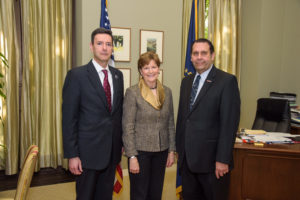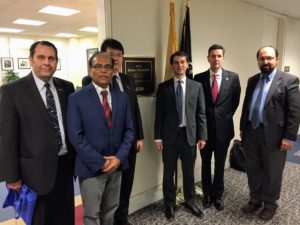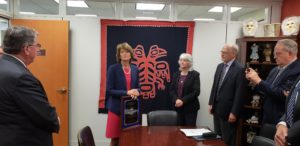Report on the NH participation in the IEEE Congressional Visits Day May 9 2018
Our DC visit unexpectedly aligned with the Congressional budget allocation process. This changed our nominal “we support STEM, R&D, and apple pie” visit to a more immediate “please allocate funding for …”. So here’s a snapshot of how the CVD process works.
We start at the IEEE USA offices with an intro to each other and key concepts related to connecting with our congressional delegation. Even in situations where we happen to have time with the Senator or Congresswoman, these typically are short photo-ops where we can plant one or two key messages. The real connections are with their staff members who are the lead persons for given areas. These are the folks that need to pull together the information to help their boss be aware of what the “constituents” think (so being in their district/ state is important, and having 1550 IEEE members in the state reflects a significant number of constituents.)
Our messages in this context, along with supporting materials provided in a “leave behind” packet, focused on the funding for NSF, NIST, DoE and to a lesser degree DoD. Allocation to these entities provides for basic research that is the foundation for IEEE’s leading technological role. Research in energy, communications, bio-tech, and more all feed into New Hampshire efforts from start-ups to BAE systems and Oracle/Dyn systems — but also into startups and the Advanced Regenerative Manufacturing Institute that is getting off the ground in Manchester. Beyond value for New Hampshire, technology is the engine driving economic growth and benefits for humanity on a national and global basis. Finally, while the U.S. is tightening budgets, other countries and the E. U. are increasing funding for research to displace U.S. leadership in leading edge areas like genomics, artificial intelligence and alternative energy.
 Our meeting with Senator Shaheen went particularly well. In addition to the photo op, Robert Zakon has had the chance to meet her in NH a few times in the last few weeks (school visit in Conway and the net neutrality discussion in Durham.) As with any human interactions, things have more impact when the first implicit question is not “who are you” but, “I know you, what do you want to say?” We had extended discussions (beyond the 15 minutes expected, and beyond the 60 minutes allocated) with a number of her staff folks (again it helped that Robert knew some, also that Robert, a recent White House Innovation Fellow, knows the lingo and hot buttons involved.) Shaheen’s science/ tech lead, Ariel Marshall was right on top of the immediate issues and was looking for specifics and data to justify support for the appropriations. All of her staff were looking for our perspectives on various issues, and the personal stories that become the “hook” to remember and advocate for the work.
Our meeting with Senator Shaheen went particularly well. In addition to the photo op, Robert Zakon has had the chance to meet her in NH a few times in the last few weeks (school visit in Conway and the net neutrality discussion in Durham.) As with any human interactions, things have more impact when the first implicit question is not “who are you” but, “I know you, what do you want to say?” We had extended discussions (beyond the 15 minutes expected, and beyond the 60 minutes allocated) with a number of her staff folks (again it helped that Robert knew some, also that Robert, a recent White House Innovation Fellow, knows the lingo and hot buttons involved.) Shaheen’s science/ tech lead, Ariel Marshall was right on top of the immediate issues and was looking for specifics and data to justify support for the appropriations. All of her staff were looking for our perspectives on various issues, and the personal stories that become the “hook” to remember and advocate for the work.
 We joined a visit to NJ Senator Mendendez’s office with Bala Prasnna a Professor from New Jersey (and Region 1 officer I’ve worked with before) and Jing Sun, a new IEEE employee — IEEE has 900+ employees in New Jersey, so that is an additional reason for congressional attention. While we sat “on the side”, Josh Sanders, the staff lead here, was quite interested in the perspective each of us brought to the table. Prof. Ali Abedi from the Maine section, joined this discussion as well, again I’ve met Ali from prior region 1 activities.
We joined a visit to NJ Senator Mendendez’s office with Bala Prasnna a Professor from New Jersey (and Region 1 officer I’ve worked with before) and Jing Sun, a new IEEE employee — IEEE has 900+ employees in New Jersey, so that is an additional reason for congressional attention. While we sat “on the side”, Josh Sanders, the staff lead here, was quite interested in the perspective each of us brought to the table. Prof. Ali Abedi from the Maine section, joined this discussion as well, again I’ve met Ali from prior region 1 activities.
One of the issues IEEE USA has been pushing is “green cards for the best and brightest” — which is to leverage the top international students in our schools by offering them the opportunity to stay in the U.S. rather than forcing them to leave after graduation. All of us in the delegation encouraged this approach and the diversity of our delegation reflects that of IEEE and the value that diverse perspectives bring to the table. In prior years a CVD message focused on the reality that 60+% of NH H1B visa’s went to outsourcing firms, and reflected a reduction in jobs for permanent residents. While there are shortages in various technology areas and H1B visas can help fill the gaps, these can also force out NH technologists, hold down wages, and tie the hands of employers in various ways (have you tried to get open bidding on IT services when they are controlled by one company already?) In short, green cards support our professional peers, and the New Hampshire motto of “live free or die”.
 Our next visit was to Alaska Senator Murkowski’s office to witness the “George E Brown Jr. Award for Science and Engineering Leadership.” She, and Rep. Jim Langevin were the 20th year recipients. Jim navigates Congress in an iBot wheel-chair — designed by Dean Kamen, just one of Dean’s inventions we found “on the hill” (the Coke machine that corresponds with Dean’s Slingshot water purification system and a Segway were two others.)
Our next visit was to Alaska Senator Murkowski’s office to witness the “George E Brown Jr. Award for Science and Engineering Leadership.” She, and Rep. Jim Langevin were the 20th year recipients. Jim navigates Congress in an iBot wheel-chair — designed by Dean Kamen, just one of Dean’s inventions we found “on the hill” (the Coke machine that corresponds with Dean’s Slingshot water purification system and a Segway were two others.)
From there we went to visit Senator Hassan. We did get a chance to talk a bit with her about basic research and benefits for NH as the ‘last photo op’ of the hour. But our time with her legislative assistants provided the real chance to get our funding and other messages across.
Our final visit was to Rep. Carol Shea-Porter. She was not available to see us, but we had an extended, fruitful and open conversation with Archna Jaiman. She was delighted to connect with non-partisan technical experts. We didn’t stay on-script, and I think that was good as well — we engaged in real discussion that helped (IMHO) to establish our credibility as both knowledgeable and not dogmatic, Is the rate of innovation increasing or decreasing, a discussion I need to continue with Robert over time, but it provided Archna a chance to get a sense for the dialog among professionals as opposed to the script that she hears all too often from lobbyists who re-iterate the paid messages.
New Hampshire Section has been an active participant in CVDs for some years. Our approach has been to send at least one experienced person, and ideally someone new to spread the experience and also our connectivity with our congressional delegations. It is a great opportunity to learn about the workings of Washington without getting too deep, and to connect for ongoing influence past the event and on topics of personal interest as well. Put January 2019 on your calendar, that is when we will be looking for the 2019 participants.
Submitted by Jim Isaak
